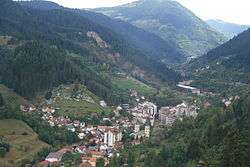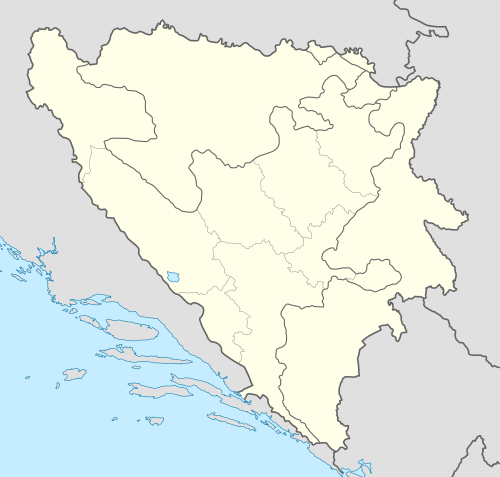Vareš
Vareš is a town and municipality located in Zenica-Doboj Canton of the Federation of Bosnia and Herzegovina, an entity of Bosnia and Herzegovina. It is situated in central Bosnia and Herzegovina, and is famous for the local mining activities and production of iron.[1] As of 2013, it has a population of 8,892 inhabitants.
Vareš Вареш | |
|---|---|
Town and municipality | |
 View on Vareš | |
 Coat of arms | |
 Vareš Location of Vareš within Bosnia and Herzegovina | |
| Coordinates: 44°09′43″N 18°19′37″E | |
| Country | |
| Government | |
| • Municipality president | Zdravko Marošević (HDZ BiH) |
| Area | |
| • Total | 390.1 km2 (150.6 sq mi) |
| Population (2013 census) | |
| • Total | 8,892 |
| • Density | 23/km2 (59/sq mi) |
| Time zone | UTC+1 (CET) |
| • Summer (DST) | UTC+2 (CEST) |
| Area code(s) | +387 32 |
| Website | www |
Geography
Vareš is a mountainous town located 45 km from Sarajevo in the valley of the small Stavnja River 828 m above sea level surrounded by the massive high Kapija, Stijene, Zvijezda and Perun Mountains, named after Perun / Перун, the highest god of the Slavic pantheon (Perkūnas/Perkons). The town is rich with archeological findings from different epochs – on several surrounding locations are found remains of prehistorical period, such as copper artifacts in Brgula.
In the town center itself, there is an old stone bridge that resembles to the majority of one arched bridges from Ottoman period. This bridge is considered to be similar by the building method to the Old Bridge in Mostar.
History
Early history
The town of Vareš has a long history with remains of metallurgical activities dating back to Bronze Age. Also during the Roman era, the town was famous for its miners and smiths.
Middle ages
During Middle Ages the Bosnian kings had their center in close proximity of the modern city of Vareš. Bosnia's greatest king, Tvrtko, considered the Vareš' village Duboštica for the center of his kingdom, since it was the mining center of his country.
Medieval
The remains of the medieval royal city and castle Bobovac were recently proclaimed as national monuments, as was the Catholic Church of St. Michael in the town of Vareš. Oldest preserved Catholic church in Bosnia can be found in the town, built in early 17th century. The town was earlier dominated by Catholic population. The church books are among the oldest preserved in Bosnia and date back to 1643.
Austro-Hungarian Empire
During the Austrian rule of Bosnia and Herzegovina the iron-works of Vareš were an important exporter of various iron products to the rest of the Habsburg empire. In 1891, the first blast furnace in Bosnia and Herzegovina was built there. That blast furnace still exists, but it ceased its operations in 1990.
World War I
In the 1910s World War I, men of the town were subject to draft, and served in the regiment BH-1, formally based in Sarajevo. They mostly saw action in the Italian and Galician fronts. The church bell was taken and melted so it could be used to produce war material.
World War II
During World War II, following the invasion and occupation of Yugoslavia, Vareš was included in the borders of the Independent State of Croatia (NDH), an Axis puppet state. In April 1945, the city was captured by the Yugoslav Partisans, and after the war became a part of the Socialist Federal Republic of Yugoslavia.
Bosnian War (1992–95)
In April 1992, the Bosnian War began and lasted until December 1995. The town of Vareš, with 12,000 residents, had a small Croat majority and was under joint control by the Croatian Defence Council (HVO) and the Army of the Republic of Bosnia and Herzegovina (ARBiH). Despite the outbreak of the Croat-Bosniak War, the relations between the local HVO and the ARBiH remained relatively good until the summer of 1993, when an ARBiH attack on the HVO in nearby Kakanj resulted in thousands of Croat refugees in the town.[2][3] In October, hostilities broke out and the local HVO took full control of the town, while most of the Bosniak population fled.[4] On 23 October, dozens of Bosniaks were killed by the HVO in the Stupni Do massacre.[2] The massacre was used as an excuse for an ARBiH attack on the Vareš enclave. The town was captured by the ARBiH in early November. Most of the Croat population fled, while the town was looted after its capture.[5] The remaining HVO units took hold in the village of Daštansko, where they remained until the Dayton Agreement was signed in November 1995.[2]
Small number of Serb and Croat population from Vareš returned in 1995, but the vast majority emigrated to United States, Canada, Australia and other West European countries. Many Croats from Vareš ended up in Croatia while Serbs fled to Republika Srpska and Serbia.
Settlements
Aside from the town of Vareš, the municipality includes the following settlements:
- Bijelo Borje
- Blaža
- Borovica Donja
- Borovica Gornja
- Borovičke Njive
- Brda* Brezik
- Brgule
- Budoželje
- Čamovine
- Ćeće
- Dabravine
- Daštansko
- Debela Međa
- Diknjići
- Dragovići
- Draževići
- Duboštica
- Hodžići
- Ivančevo
- Javornik
- Kadarići
- Karići
- Kokoščići
- Kolovići
- Kopališta
- Kopijari
- Krčevine
- Kunosići
- Letevci
- Ligatići
- Luke
- Ljepovići
- Mijakovići
- Mir
- Mižnović
- Mlakve
- Naseoci
- Neprivaj
- Oćevija
- Okruglica
- Orah
- Osoje
- Osredak
- Ostrlja
- Pajtov Han
- Pajtovići
- Planinica
- Pobilje
- Podjavor
- Pogar
- Položac
- Poljanice
- Pomenići
- Pržići
- Pržići Kolonija
- Radonjići
- Radoševići
- Ravne
- Rokoč
- Samari
- Semizova Ponikva
- Seoci
- Sjenokos
- Slavin
- Sršljenci
- Strica
- Striježevo
- Stupni Do
- Šikulje
- Tisovci
- Toljenak
- Tribija
- Vareš Majdan
- Vijaka Donja
- Vijaka Gornja
- Višnjići
- Zabrezje
- Zaruđe
- Zubeta
- Zvijezda,
- Žalja i Žižci
Demographics
| Year | Pop. | ±% p.a. |
|---|---|---|
| 1971 | 23,532 | — |
| 1991 | 22,203 | −0.29% |
| 2013 | 8,892 | −4.07% |
According to the 2013 census results, it has a population 8,892 inhabitants. Population decline is evident since the end of the Bosnian War, as nearly two thirds of the population from 1991 left Vareš in only twenty years.[6]
Ethnic groups
- 1971
23,523 total
- 11,134 Croats (47.33%)
- 6,631 Bosniaks (28.18%)
- 5,166 Serbs (21.96%)
- 307 Yugoslavs (1.30%)
- 285 Others (1.23%)
- 1991
22,203 total
- 9,016 Croats (40.61%)
- 6,714 Bosniaks (30.24%)
- 3,644 Serbs (16.41%)
- 2,071 Yugoslavs (9.32%)
- 758 Others (3.44%)
The town of Vareš had a total population of 5,888, composed of:
- 3,035 Croats (51.54%)
- 1,068 Bosniaks (18.13%)
- 627 Serbs (10,64%)
- 859 Yugoslavs (14.58%)
- 299 others and unknown (5.07%)
- 2013
8,892 total
- 5,447 Bosniaks (61.3%)
- 2,820 Croats (31.7%)
- 189 Serbs (2.1%)
- 436 others (4.9%)
The town of Vareš had a total population of 2,917, composed of:
- 1,339 Bosniaks (45.9%)
- 1,254 Croats (43%)
- 71 Serbs (2.4%)
- 253 others (8.7%)
Tourism
The Vareš region also has possibilities for winter tourism development. Due to its position and elevation snow stays longer than in other regions, and the beautiful areas surrounding it are really good for skiing and skating. The mountain resort Doli is located on Zvijezda Mountain.
List of mayors
- Ivica Džoja 1954–1963; KPJ
- Mile Markić 1963–197x; KPJ
- Slobodan Milanović 197x–197x; KPJ
- Salko Operta 1974–1978; KPJ
- Rešad Žutić 1981–1983; KPJ
- Željko Franjkić 1986–1988; KPJ
- Pero Jarčević 1988–1989; KPJ
- Mladen Zovko 1989–1990; KPJ
- Dario Andrijević 1990–1992; KPJ - SDP BiH
- Anto Pejčinović 1992–1993 HDZ BiH
- Mervana Hadžimurtezić 1992–1998 SDA
- Samir Musa 1998–2000 SDA (joint mayor)
- Pavao Vidović 1998–2000 HDZ BiH (joint major)
- Ermin Musa 2000–2001 SDA
- Hamdo Fatić 2001–2012 SDP BiH
- Avdija Kovačević 2012–2016 SDA
- Zdravko Marošević 2016–present HDZ BiH
Notable people
- Borislav Stjepanović, actor
- Ipe Ivandić, musician
- Milo Cipra, music composer
- Slaven Stjepanović, footballer
- Željko Ivanković, poet and writer
- Matija Divković, Bosnian Franciscan writer
References
- Jelin - Dizdar, Tina (22 March 2013). "Razglednica iz Vareša: Grad koji je uspio sačuvati zajednički život". slobodnaevropa.org (in Serbian). Retrieved 21 June 2018.
- Central Intelligence Agency, Office of Russian and European Analysis (2002). Balkan Battlegrounds: A Military History of the Yugoslav Conflict, 1990–1995, Volume 2. Washington, D.C.: Central Intelligence Agency. p. 437-440. ISBN 978-0-16-066472-4.
- Shrader, Charles R. (2003). The Muslim-Croat Civil War in Central Bosnia: A Military History, 1992–1994. College Station, Texas: Texas A&M University Press. p. 137. ISBN 978-1-58544-261-4.
- CIA 2002b, pp. 437–440.
- Shrader, Charles R. (2003). The Muslim-Croat Civil War in Central Bosnia: A Military History, 1992–1994. College Station, Texas: Texas A&M University Press. p. 157. ISBN 978-1-58544-261-4.
- Mujkić, Semir (19 September 2016). "ŽIVOT NA TEKU: Vareš danas ima stanovnika koliko je nekada imao radnika". zurnal.info (in Serbian). Retrieved 21 June 2018.
External links
| Wikimedia Commons has media related to Vareš. |
- http://www.vares.pp.se/
- http://www.vares-x.com.ba/
- Web magazine with current information on the city - in Croatian
- http://www.zupavares.com/
- http://www.vares.info/
- Tragovima bosanskog kraljevstva - Tourist route for medieval Bosnia
- Trail of the Bosnian Kingdom - Cultural Tourism in Vares